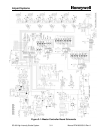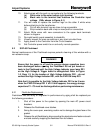
Airport Systems
SG-60 High Intensity Strobe System 4-2 Manual EPM-00000019 Rev A
The charts assume that that you have already eliminated these as possible causes for
the observed problem.
The charts may instruct you to make temporary changes for testing (such as select
operating modes manually, or installing a jumper). These temporary measures are
marked with rectangles with rounded corners. Always return the systems to their
normal state after completing your troubleshooting. To reduce chart complexity,
the charts not specify the individual actions necessary.
Multiple strobe problems are most commonly cause by faults in the communications
cabling. If you have determined that there is a short or break, we recommend
disconnecting communication wiring leading to the upper sections of the tower while
checking and/or repairing the lower sections. Individual flashheads may be isolated in
the same way. Using this technique, work upward from one flashhead level to the next,
to create known good wiring (per Section 2.5.4).
If the cable test shows an open between TB5-A and TB5-B even though a terminator is
set in a top-most strobe, then there is a break in either the A or B line. Use the
following test to determine if the break is above or below a Flashhead level.
1. Remove all power from Flashheads and Master Controller at the main circuit
breakers.
2. Unplug Data Cable connector TB5 from PCB1 in Master Controller.
3. In one of the Flashheads on a given level, install a jumper (or alligator clip)
between TB1-4 and TB1-5.
4. Verify short circuit between (<20 ohms) TB5-A and TB5-B (both on Data Cable).
If the measurement is open instead, the break is below that Flashhead level.
5. Remove the jumper between TB1-4 and TB1-5.
6. Plug Data Cable Connector TB5 back into PCB1.
The Troubleshooting charts use the following abbreviations:
FH Flashhead
MC Master Controller
DB Digital Board (inside the SGF-60 Flashhead)
THVB Trigger/High-Voltage Board (inside the SGF-60 Flashhead)
RLC Red-Light Controller (such as Honeywell’s 9LCA series).


















